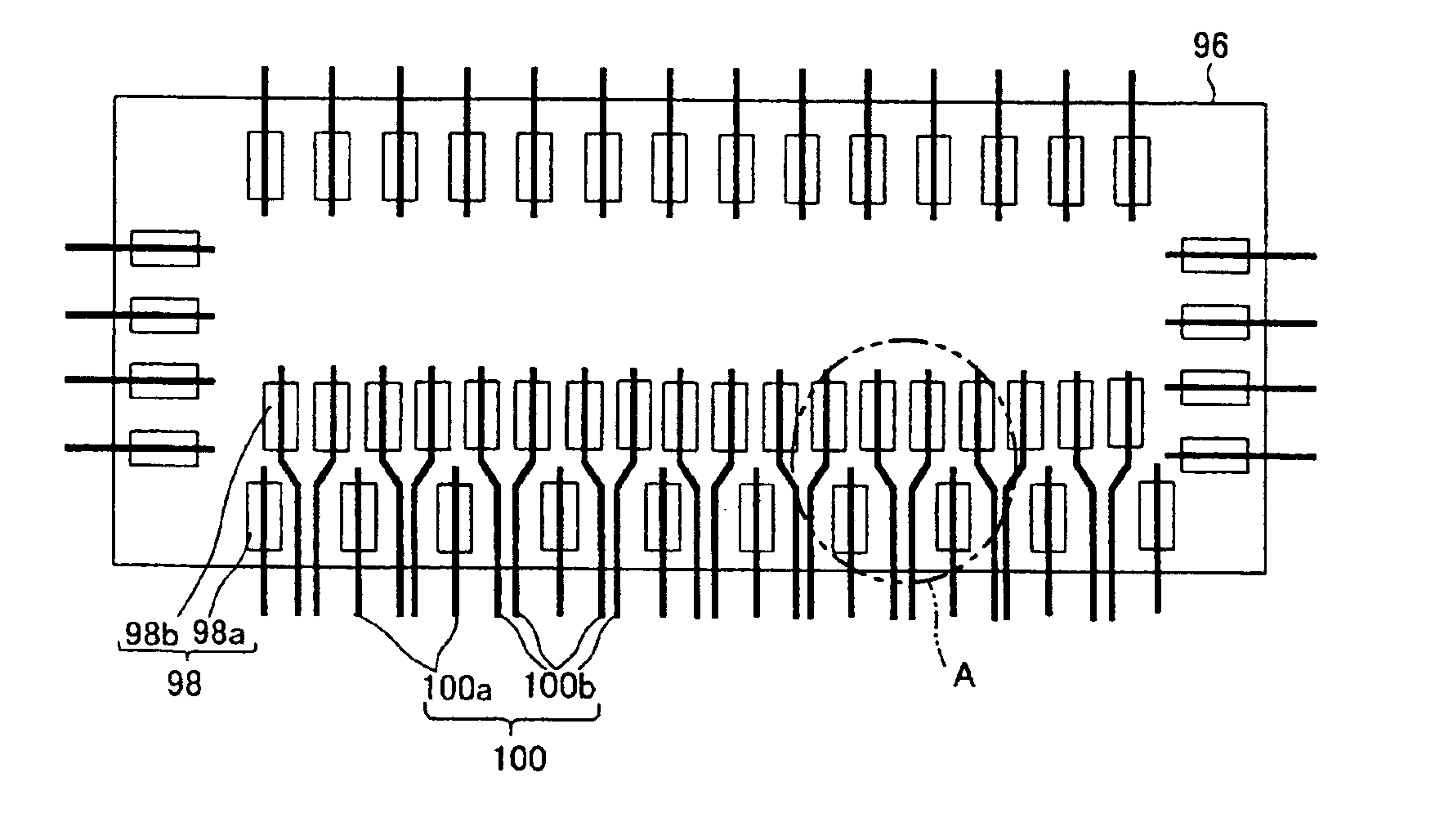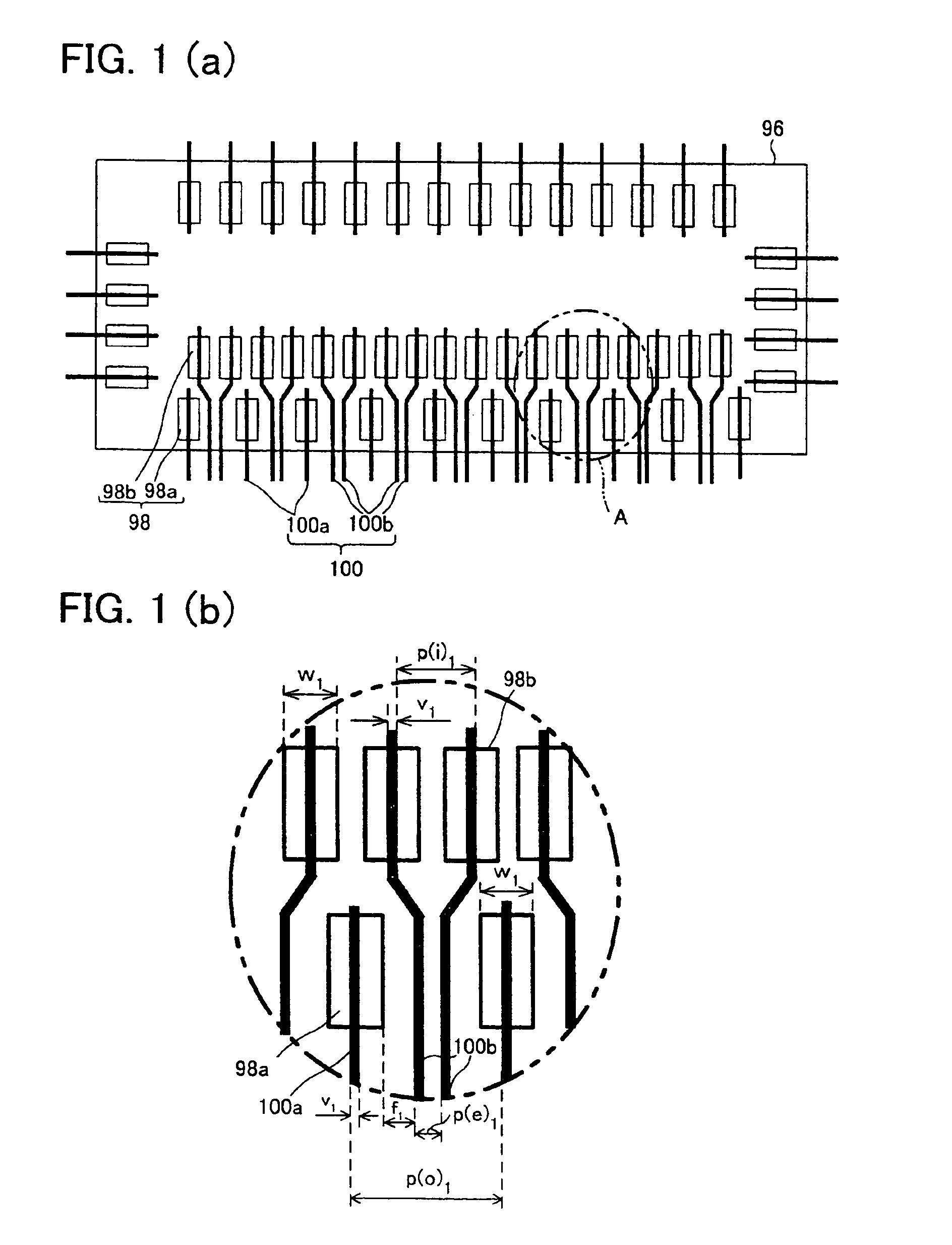Semiconductor device
a technology of semiconductor devices and internal leads, applied in semiconductor devices, semiconductor/solid-state device details, electrical apparatus, etc., can solve the problems of difficulty in further improving fine pitch, difficulty in realizing fine pitch improvement, and lowering so as to improve the fine pitch of inner leads and improve the bonding accuracy of inner leads
- Summary
- Abstract
- Description
- Claims
- Application Information
AI Technical Summary
Benefits of technology
Problems solved by technology
Method used
Image
Examples
embodiment 1
The following will describe one embodiment of the present invention with reference to FIG. 1 through FIG. 4.
As shown in FIG. 2(b), a COF (Chip On Film; semiconductor device) of the present embodiment includes an inner lead (lead wire) 100 supported by a film substrate 101 and a bump electrode 98 provided to a semiconductor chip 96 which are placed so as to be opposed each other and to be electrically connected to each other.
On the inner lead 100 provided on the film substrate 101, formed is a solder resist 94 as protective film made of polyimide or polyurethane material having high heat resistance. The solder resist 94 is provided to prevent damage to the inner lead 100 such as corrosion and leak failure, caused by the adhesion of conductive or ionic foreign substance. The solder resist 94 also prevents the inner lead 100 from be broken by external force and protects the inner lead 100 in the process of bending. Note that, the solder resist 94 is formed to a thickness of 3 μm to 30 ...
embodiment 2
The following will describe another embodiment of the present invention with reference to FIG. 5. Note that, for the purpose of explanation, members having the same functions as those illustrated in drawings of Embodiment 1 are given the same reference numerals and explanations thereof are omitted here.
In a semiconductor chip 96 of the present embodiment, as shown in FIG. 5(a), bump electrodes spaced at predetermined pitches are arranged in three rows respectively at different distances from the end of the semiconductor chip 96. Hereinafter, the bump electrodes arranged in three rows are referred to as a first bump electrode (edge-side bump electrode) 68a, a second bump electrode (first inner-side bump electrode) 68b, and a third bump electrode (second inner-side bump electrode) 68c in the order of being relatively small distance apart from the end of the semiconductor chip 96. When any one or all of the first bump electrode 68a, the second bump electrode 68b, and the third bump ele...
embodiment 3
The following will describe still another embodiment of the present invention with reference to FIG. 6 and FIG. 7. Note that, for the purpose of explanation, members having the same functions as those illustrated in drawings of Embodiments 1 and 2 are given the same reference numerals and explanations thereof are omitted here.
In a COF of the present embodiment, some of the inner-side bump electrodes 58b in the COF shown in FIG. 4(a), which has been described in Embodiment 1, are placed so as to be different from the others in distance from the end of the semiconductor chip 96. More specifically, as shown in FIG. 6, a bump electrode 77 is placed at a position more distant than the position of the inner-side bump electrode 58b from the end of the semiconductor chip 96. Moreover, the bump electrode 77 is placed in a different direction from a direction in which the outer-side bump electrode 58a and the inner-side bump electrode 58b are provided. That is, the bump electrode 77 is so pro...
PUM
 Login to View More
Login to View More Abstract
Description
Claims
Application Information
 Login to View More
Login to View More - R&D
- Intellectual Property
- Life Sciences
- Materials
- Tech Scout
- Unparalleled Data Quality
- Higher Quality Content
- 60% Fewer Hallucinations
Browse by: Latest US Patents, China's latest patents, Technical Efficacy Thesaurus, Application Domain, Technology Topic, Popular Technical Reports.
© 2025 PatSnap. All rights reserved.Legal|Privacy policy|Modern Slavery Act Transparency Statement|Sitemap|About US| Contact US: help@patsnap.com



